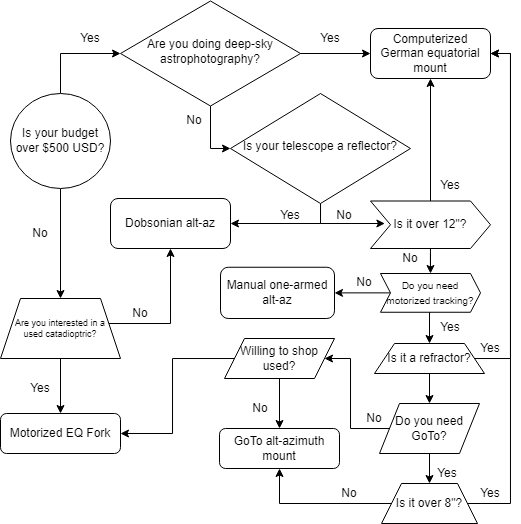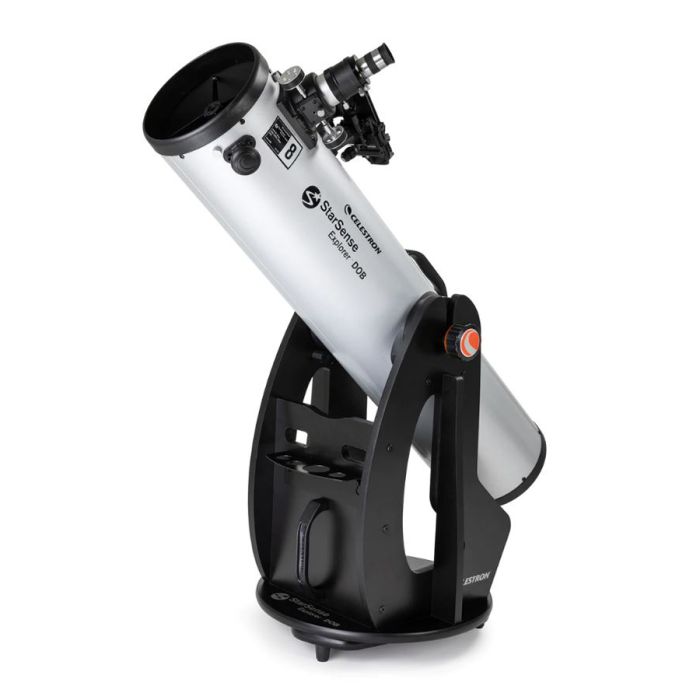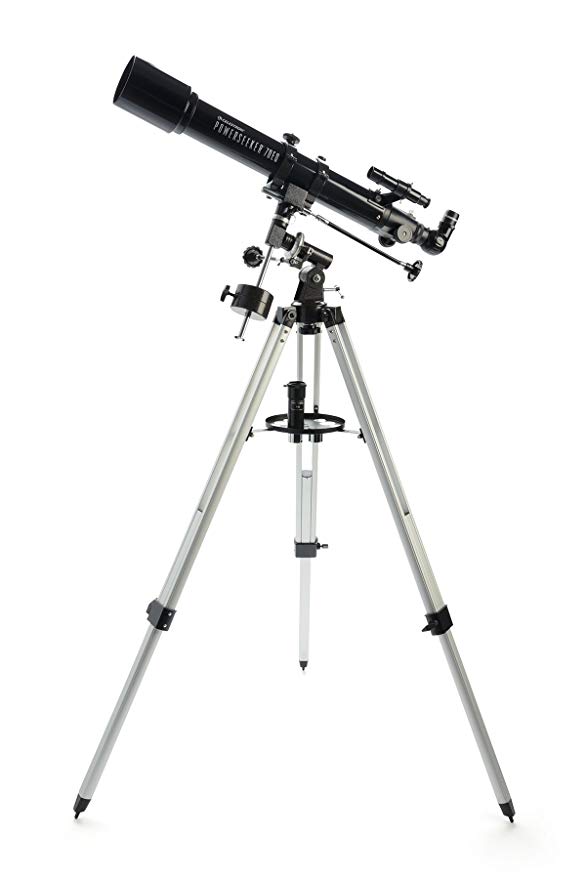Telescope mounts come in two main configurations: altitude-azimuth (also known as alt-az) and equatorial. Alt-azimuth and equatorial mounts have unique advantages and disadvantages, and knowing which mount type is right for you is important when choosing a telescope.
An equatorial mount is a type of mount used for telescopes and sometimes cameras that allows the instrument to move in a way that follows the rotation of the Earth along a single axis, or right ascension, with the telescope’s right ascension axis pivoting east-west. An equatorial mount will track objects with a simple “clock drive,” which spins the entire right ascension axis once over a 24-hour period, or simply by turning a fine-adjustment knob to move the telescope westward across the sky. The other axis, declination, adjusts pointing in the north-south direction.
On the other hand, an altitude-azimuth mount is a type of mount that allows an instrument to move in two axes: altitude (up and down) and azimuth (left and right). This type of mount is simpler than an equatorial mount but requires constant adjustment in both directions, which must vary depending on where the telescope is pointed. As such, alt-azimuth mounts can only track the sky if they have a computerised pointing system.
Even with motorised tracking, however, it is hard to use alt-azimuth mounts for long-exposure astrophotography because the target object will appear to flip on its side as the telescope moves, and it is harder to make automatic guiding adjustments for accurate tracking. Alt-azimuth mounts are generally used in conjunction with special tools like derotators for long-exposure astrophotography with very large telescopes of 16” or larger aperture, where an equatorial mount would simply be too difficult to construct or house, and a derotator and other expensive measures are a better solution.
Overall, for astrophotography, an equatorial mount is more suitable for tracking objects in the sky over long periods of time, which is really the only reason to buy one, while an altitude-azimuth mount is more suitable for visual observations and is definitely what you want for your first telescope.

Alt-Azimuth Mount Types
Alt-azimuth mounts can come in a few configurations, each with different pros and cons. Many cheap alt-azimuth mounts are built exactly like a camera tripod, with the telescope suspended above the altitude axis and riding on a single pivot, often with no fine adjustments or sloppy ones at best. These mounts have to have the altitude axis locked or at least tightened when aimed above the horizon, or else they will simply allow the telescope to drift upward or even fall over. They are extremely annoying to adjust, and they are often shaky too. Avoid these mounts! If you’re on a budget, a Dobsonian telescope is best in lieu of small alt-azimuth-mounted refractors and reflectors.

Fork mounts keep the telescope suspended between two pivots and are commonly seen with computerised Schmidt-Cassegrain telescopes. One-armed fork mounts simply have a single pivot to move up and down, making them less sturdy for larger and heavier instruments; one-armed forks are also the type usually seen in well-designed manual alt-azimuth mounts. A typical manual one-armed fork keeps the telescope at the centre of gravity on the altitude axis and has slow-motion adjustment cables for tracking and fine-pointing capabilities, much like a manual equatorial mount does. Manual alt-azimuth mounts are ideal for smaller tripod-mounted instruments, while GoTo alt-az mounts are great with larger catadioptric telescopes that need tracking and may be difficult to find objects manually on account of their long focal lengths.
The Dobsonian mount is named after its inventor, John Dobson, and is often used for large reflecting telescopes. It consists of an alt-azimuth mount that (ideally) has no clutches or gears. The design resembles a fork mount but relies on friction and gravity rather than any gears or metal bearings. Instead, the telescope pivots using laminate on Teflon pads to glide smoothly up and down on large cylindrical bearings, spinning in azimuth with a laminate-covered bottom board riding on more Teflon.
The Dobsonian design is cheap to make, fairly lightweight, and compact as the telescope is essentially part of the mount, and the whole thing has a low centre of gravity. Most manufacturers do not follow the ideal design of the Dobsonian. Unfortunately, many commercial Dobsonians have too-small altitude bearings, which require spring tensioning, clutches, a sliding tube, and/or counterweights to maintain balance and smooth motion, or are of one-armed fork designs. A lot of commercial Dobsonians’ altitude bearings also use inadequately sized Teflon pads, too-sticky laminate, or even just ditch the Teflon and laminate and ride a “lazy Susan” type roller bearing instead, which can be extremely frustrating to use, especially when trying to track at higher magnifications.
Dobsonians, even in their less-than-perfect forms, usually have smooth motions and are extremely easy to set up and use without the faults of sticky gearing, a wobbly tripod, or confusing GoTo computer systems, which make them ideal for beginner telescopes. For larger instruments, they are the only option for a cheap, portable instrument that can be used to look at the deep sky.
Equatorial Mount Types
There are actually a huge variety of equatorial mount types, but most are variations on the same basic idea of either suspending the telescope in between the declination axis or outboard of it. The former is inherently less stable or portable, while the latter requires counterweights.

Fork mounts “tilted” on a wedge, which is essentially an angled plate that converts an alt-az fork’s azimuth axis to a right ascension axis and altitude axis to declination, are the most common inboard design. The problem is that the telescope is unstable in this setup because the heavy drive base of the fork is placed at a point that is not in the middle of the pier or tripod. Additionally, the right ascension axis has a huge amount of weight bearing down on it at an angle, as it rests on only a single pivot point.
If you were to extend the equatorial forks so that they met again at some point above the telescope tube at a second pivot point, you’d have an English yoke mount. The English yoke mount is actually a really clever design, but it’s not portable, and the top of the right ascension axis means the telescope can’t point near the north celestial pole. Enlarging the top bearing and cutting a hole in it produces the horseshoe mount design, which has been used for many older research telescopes like the 200-inch Hale telescope. Horseshoe designs are sometimes seen in semi-portable amateur telescopes but are uncommon as they are complex to construct and still rather bulky.
Equatorial mounts with the telescope on the outside of the declination axis are inherently more portable than inboard designs and also make it much easier to interchange different telescopes on the same mount. The downside is that they require counterweights and often put the eyepiece in an uncomfortable position if you’re looking through the telescope. The height and angle of the eyepiece vary enormously, and you almost certainly will have to rotate the telescope tube (or star diagonal) in its rings to comfortably place the eyepiece, depending on where you are aimed in the sky.
Occasionally, designs such as the inverse fork and cross-axis English yoke mount are built, but the only one you’re likely to ever see is the German equatorial mount, or GEM. German equatorial mounts are fairly simple in construction and allow easy use atop tripods, as well as the installation of a miniature telescope through the centre of the right ascension axis to aid in accurate polar alignment.
Which Mount is Best for Me?
Equatorial mounts used to be seen as the only form of “serious” telescope mount, as telescopes used to have long tubes that shook in the wind or when adjustments were made, along with eyepieces with narrow fields of view requiring that the telescope be nearly perfectly centred on a target, so making fewer pointing adjustments was a huge plus. Today’s eyepieces have much wider fields of view and the designs of alt-azimuth mounts have come a long way; computerised pointing is also available for both equatorial and alt-azimuth designs. As such, the advantages of an equatorial mount are really only beneficial for astrophotography.
Many cheap tripod-mounted telescopes are less-than-steady due to low-quality tripods and often have lots of backlash and other issues in the mount. This is particularly true with cheap German equatorial mounts. You are not going to be doing long-exposure astrophotography with an EQ mount/telescope package costing less than $1,000 USD, so don’t choose your telescope based on the purported advantages of one of these mounts.
We strongly recommend Dobsonian alt-azimuth mounts to beginners. Manual fork or one-armed fork alt-azimuth mounts are great for refractors as well as smaller reflecting and catadioptric telescopes; however, a good alt-az mount can be somewhat expensive, and very cheap ones often have an outboard design which makes aiming frustrating. Computerised or GoTo alt-azimuth mounts are not very necessary with smaller instruments, but they do add tracking.
Catadioptric telescopes of 8” or larger aperture usually have very long focal lengths and thus really need some kind of tracking and/or computerised mount, which can be either an alt-azimuth or equatorial design. The prime advantage of an equatorial mount with a larger Schmidt-Cassegrain telescope is that a GEM can be separated from the telescope tube and dismantled, whereas a computerised fork mount is heavy, bulky, and must be transported attached to the tube, which can be extremely difficult to do without help. However, an alt-azimuth fork is steadier, keeps the eyepiece more accessible, and is less complex to actually set up than a GEM. You can also convert many computerised alt-azimuth forks to an equatorial fork mount with a wedge for deep-sky astrophotography, though.
In general, we would only recommend a German equatorial mount for larger refractors, Schmidt-Cassegrains, or deep-sky astrophotography. For everything else, the alt-azimuth mount design is king.
